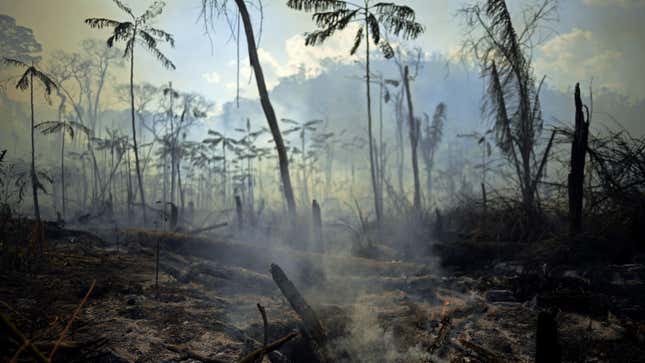
Huge swaths of the Amazon have gotten so dry that they may be on the brink of transitioning into an entirely different kind of ecosystem, new research published in Nature Communications warns.
Rainforest ecosystems are very sensitive to changes in precipitation, since their rich, wildlife-sustaining foliage depends on receiving moisture. But thanks to climate change, the world’s tropical regions are becoming drier. With this in mind, researchers wanted to see how stable tropical rainforests around world are to these changing conditions.
To do so, the team ran computer models of different climactic conditions, examining where the world’s rainforests might be expected to survive in tropical areas around the world over time, and how much tree coverage those forests would have. The researchers found that the rainforests of Indonesia and Malaysia are relatively stable because their precipitation is more dependent on the oceans that surround them, rather than on canopy cover.
But the Amazon is particularly delicate and reliant on regulating itself. The researchers found that much of the Amazon rainforest is already seeing so little rainfall that it could begin a potentially irreversible transformation.
“In around 40 percent of the Amazon, the rainfall is now at a level where the forest could exist in either state—rainforest or savanna, according to our findings,” lead author Arie Staal, an environmental scientist who was until recently a postdoctoral researcher at the Stockholm Resilience Center and the Copernicus Institute of Utrecht University, said in a statement.
That’s not to say these parts of the Amazon are already savanna; the shift would still take decades to be completed and involve species dying off along with fundamental shifts in the food chain. But the transformation begins with rainfall loss, and once it happens, it can be very difficult to reverse.
In some places, the changes may already be underway. “There is evidence that in some places it is occurring,” Staal added in an email, citing the rainforest’s floodplains as an example.
Recently, the region’s rainy seasons have been thrown out of whack. Severe droughts have hit three times since 2005. In some parts of the Amazon, the dry season has grown almost a month longer over the past 50 years.
Rainforests create their own precipitation because the moisture from their plants evaporates and falls. But as the regions get drier, rain is becoming more scarce. This dryness creates conditions ripe for forest fires, which results in fewer trees. This creates a dangerous feedback loop, because less foliage in turn creates less precipitation.
Researchers have long warned that if this trend became severe enough, the rainforest could turn into a savanna, and recent reports have warned that this could take place within our lifetime. But the new study shows that they could be here far sooner than we previously thought.
Without urgent measures, the climate crisis will take an even worse toll on the Amazon. The team ran computer simulations of the climate conditions that we’ll see if greenhouse gas emissions kept rising, and found that overall, as emissions grow, the Amazon becomes less resiliant to dry conditions. Trees are less likely to grow back, and the switch to becoming a savanna-type ecosystem becomes more likely.
The researchers only focused on climate-related changes in the Amazon, but the rainforest is also vulnerable because of manmade fires. Of late, the Amazon is a been burning at a record rate, and most blazes have been lit by land-grabbers, developers, and agribusiness. This exacerbates the conditions that lessen rainfall, pushing the rainforest closer to the brink of collapse. It also means the study’s estimates may be conservative.
If the rainforest becomes a savanna, we’re all in trouble. The Amazon is one of Earth’s most biodiverse regions, and it sustains Indigenous communities. It is also one of the largest carbon sinks on the planet. Over time, it will become less and less able to perform these essential functions, unless we draw down our greenhouse gas emissions and protect it.
Update 10/5/2020, 5:43 p.m. ET: This story has been updated to include additional comment from Staal.